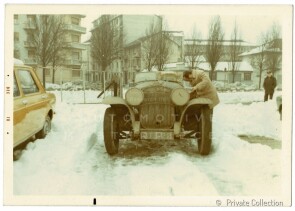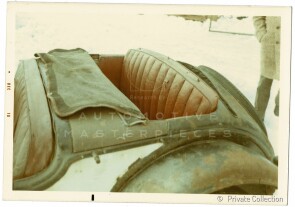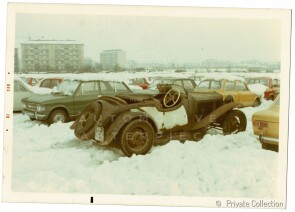
1931 Fiat 522 C Torpedo Sport
ON/OFF
Why am I an Automotive Masterpiece?
L. Limited edition cars
no. 3 manufactured, no. 1 remaining
In the Italy of the roaring years, between the desire to "Vivere senza malinconia" (live without melancholy) and the dark shadows of the 1929 economic crisis, before history precipitated, people built and created cars in which charm and sportiness went hand in hand. The Fiat 522 is a “mid to high” range car produced from 1931 to 1933. It descended from the Fiat 520, the forefather of 6-cylinder Fiat cars. The 522, presented in 1931 at the IV Salone dell'Auto di Milano, was sold in three different versions, distinguished by different chassis’ lengths, each 522 C (short version), 522 L (long version) and 522 S Sport (sports version). The latter had a frame characterised by an intermediate wheelbase between the Fiat 522 C and the Fiat 522 L and was presented at the 1932 Geneva Motor Show. The 522 was equipped, for the first time in Italy, with hydraulic split-circuit brakes and a 4-speed manual gearbox with third and fourth speeds synchronised. It had an in-line six-cylinder engine with side valves, 2516 cm³ of displacement, with 52 hp (65 hp in the S version). The 522L reached the maximum speed of 95 km/h, while the 522C 105 km/h and the 522S reached a speed of 115 km/h. A CSS version was also built, with elegant finishing and an even more powerful engine. The ignition was battery-powered, the car was rear-wheel drive and was sold as a sedan (two and four doors), torpedo (four doors), Cabriolet (two and four doors) and coupé (two doors). A total of 7,360 specimens were built (of which 4,706 "C", 1,922 "L" and 722 "S"). With this car and the Fiat 524, the Turin-based carmaker inaugurated a new logo, rectangular with a red background and gold letters. This logo was used between 1931 and 1932. The Fiat 522 run successfully many races, although its sporting history is less known and documented than other cars. A 522, drove by Pietro Ferrero and Renzo Monaco at the 1933 Mille Miglia, ranked 41st overall. The Carrozzeria Viotti in Turin was active from 1921 to 1964 and is known for its "tailor-made" cars. In the 20s it registered the patent for the "Clairalpax body", using thin pillars in alpacca which allowed a substantial increase in the glass surfaces. The company is important for the history of the Italian automobile as it created the Fiat 1100 “Giardinetta,” based on a design by Mario Revelli de Beaumont. The Giardinetta, in 1946, participated in the birth of modern station wagons.
The Fiat 522 C, chassis no. 002336 is the only surviving car of this type (Torpedo Sport). Presented in 1932 at the Olympia Motor Show in London, where it was hailed as the model that marked Fiat's great return to sports cars, it has a Viotti body, designed by Mario Revelli de Beaumont, also the designer of the 525 SS. In the 30s, he devoted himself mainly to the design of luxury and sports models, especially for Isotta Fraschini and Fiat, collaborating with Pinin Farina, Viotti and Bertone. While in Fiat, he was the author of many drawings as the famous design of the 1935 Fiat 1500 (6C). In this period, throughout Europe, the stylistic preference was for sinuous and aerodynamic lines, with a great show of fairings. This style, known with the French term "flamboyant", had its greatest exponent in Italy in Mario Revelli de Beaumont. There are reports of two cars assembled (one is the chassis no. 002336) with a high-compression S-head and two single-barrel vertical Solex carburettors, which had 65 hp. Moreover, there was a probable third car equipped with two double-barrel carburettors. The car with chassis no. 002336 is the only one of which there are reports and images. Of two/three specimens, this car might be the only one ever built and it’s the only surviving. The car was also successful abroad, as shown by the British specialist press of the time that defined it as "a lively car of attractive appearance". According to an article in Veteran and Vintage Magazine dated February 1974, the Fiat 522 C Torpedo Sport (Viotti) is precisely the example presented at the 1932 Olympia Motor Show in London and subsequently road-tested by Motor Sports magazine. According to the article, the car could have participated in the 1931 edition of the same motor show, but this is not proven. The car then received the GT522 registration plates in 1933, when it was specially registered by FIAT (England) Ltd.; plates transferred from another car formerly in their press set. The car, chassis no. 002336 was found in England at the end of the 60s/early 70s by enthusiasts Giulio Vignale, Pippo Vaccari, Carlo Vaccari. Brought back to Italy at the end of 1970, complete but in need of a total restoration, it was purchased by Giulio Vignale himself who, with a patient restoration that lasted about 20 years, brought the car back to its former glory. He then matriculated the car (in 1972) with custom plates, TOG00522: "Togo" is a Turin dialectal expression used to say "cool" and seems to derive from the Hebrew ṭōb, "good, excellent", while the 522 number explains itself. In 1991, after long and exhausting bargaining, Vignale sold the chassis no. 002336 to Teodoro Somasca, an entrepreneur and renown car-collector. The car, with its beautiful proportions, a mixture of aggressiveness and elegance underlined by the two-tone ivory-red colour, is today with an almost thirty-year restoration but in an impeccable condition, in perfect working order and used in many documented meetings such as the Circuito della Superba, the Concorso Città di Torino, the Targa Florio, the Circuito del Lario. Among the amenities that characterize this car: the "elastic" steering wheel of English production, typical of the time, replacing the original Fiat steering wheel; the additional adjustable spotlight with integrated rearview mirror and the water thermometer on top of the radiator, with two faces - a visible thermometer, towards the passenger compartment and the acronym "522" on a green background towards the front.




